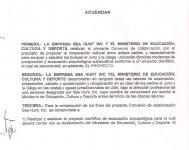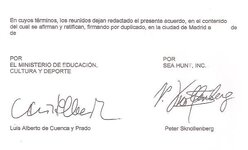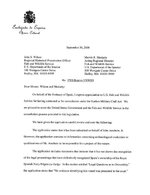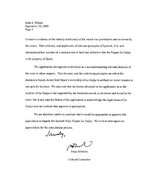1750treasure
Greenie
The world is now following the Odyssey marine case with renewed interest. Odyssey has lost every step of the way in the federal courts in their bid to keep 17 tons of treasure. In Spain, the gloating has begun before the treasure has arrived. I have seen numerous articles in the Spanish press that refer back to La Galga and the Juno and Spain’s victory in the Sea Hunt case. It is time to take another look at a case that, at least in the eyes of Spain, is the precedent that helped them beat Odyssey. Odyssey has been called a pirate and a plunderer who has no respect for Spain’s history. Spain says this is all about their cultural heritage. The Sea Hunt case documents that they have little respect for ours.
La Galga actually lies buried in the Chincoteague National Wildlife refuge. This location has been known to the federal government since 1983. Presently, the Kingdom of Spain and the federal government are blocking archaeological verification of this site because its verification would ultimately decimate the precedent in the Sea Hunt case. La Galga is a very important historic wreck. It is the galleon that legend says brought the horses that run wild on Assateague today. This legend has already been documented in the movie, Misty of Chincoteague www.youtube.com/watch?v=FX9wIU0k-nU. Hundreds of thousands of tourists travel to Assateague and Chincoteague each year just to see these beautiful animals running wild. La Galga has another place in history. On her last voyage, she was escorting the galleon Nuestra Senora de Guadalupe which became disabled at Ocracoke Inlet, North Carolina. Her treasure was stolen and buried in the Caribbean. This event would inspire, in part, Robert Louis Stevenson when he wrote Treasure Island. See my post in this forum Norman Island (BVI) is Treasure Island http://forum.treasurenet.com/index.php/topic,427927.0.html. Also you can read more at www.treasureislandtheuntoldstory.com. This shipwreck has international historical significance and Spain has taken it hostage. All of the questions you have I am sure will be answered here in my complete analysis of Sea Hunt and these two shipwrecks www.thehiddengalleon.com/the-sea-hunt-case.htm. This analysis also documents that the Juno is hundreds of miles from the site awarded to Spain.
For those of you who will argue that the court ruled that the shipwrecks belong to Spain regardless of where they are located are incorrect. This was an in rem admiralty action. The suit was about the artifacts arrested. Spain never offered any proof that these belonged to them. They couldn’t because they weren’t. To put this scenario in simpler terms it is like this:
Imagine yourself sitting at home watching the news about the murder trial of Richard Roe. He is accused of killing his wife Rhonda. You hear that Richard has exonerated himself by testifying that you killed his wife. That’s bad enough but you hear that you have already been convicted by the court based on the evidence presented before you are even arrested. You are going straight to jail without a trial. Your name is Sea Hunt.
In the last pleading filed in the Sea Hunt case, the Commonwealth of Virginia summed it up this way:
“No court has ruled that La Galga and the Juno have in fact been found or that their remains lay within the two search areas. So, what Sea Hunt and Spain seem to forget is that no one knows whether the recovered artifacts came from La Galga or Juno, nor does anyone know whether Sea Hunt has located either La Galga or Juno. Without that knowledge, at a minimum, no one knows whether any given artifact belongs to Spain or to Virginia, and no one knows the recovery spots identify wreckage that belongs to Spain or Virginia….Sea Hunt is in the untenable position of possibly having to answer to Virginia for giving away Virginia’s property.”
A formal adjudication of whether the recovered artifacts belong to Spain, and whether Sea Hunt has indeed located La Galga and Juno, is more important than ever. The ownership contest is not between Sea Hunt and Spain, but between Virginia and Spain, as Sea Hunt has no ownership interest in either the artifacts or the vessels, except as contractually provided in the permits. Adjudication is important, because both Sea Hunt and Spain have changed their positions on these issues.”
“Sea Hunt has not unequivocally asserted it has possession, actually or constructively, of La Galga or Juno…Likewise, Spain has never admitted, even now, that Sea Hunt has found La Galga and/or Juno.”
Virginia recalled the affidavit of David Beltran Catala of the Spanish Embassy that was filed on May 26, 1999: “In summary, I state that Spain objects to any salvage award concerning Juno on grounds that:… Sea Hunt has not located the Juno or otherwise achieved success that could merit a salvage award…”
“The memoranda of both Sea Hunt and Spain, particularly Spain, contain numerous allegations of contumacious conduct and ad hominem attacks.”
Virginia asked that an item by item inquiry be conducted on the artifacts. The burden of proof would lie with Spain. It never happened.
The Kingdom of Spain has abandoned La Galga and the Juno in favor of two unidentified shipwrecks that they knew were not the actual ships. The souls of four hundred and thirteen soldiers, sailors, and a handful of women and children have been waiting for their watery grave to be discovered. They have watched their homeland abandon them for the sake of political expediency and a legal precedent. They heard the statements in court that their ship had not been found. They saw the proper documentation that would have faithfully recognized their last day on earth, which could and should have been presented to the American arbiter, was not presented, thus resulting in a ruling by 4th Circuit that would torment their souls through eternity. As for La Galga, Spain has breached the stipulation that they agreed to on April 1, 1999 that La Galga was in the ocean lying within three miles of the beach. Without that stipulation, Spain would have had no standing to even be in the case. Now they are preventing archaeological investigation of a site on American soil that has great historical significance. Fortunately there are no graves associated with this shipwreck. Spain is quite happy to display the artifacts, property of the Commonwealth of Virginia improperly taken in the Sea Hunt case, and have them displayed in a National Park of the United States as souvenirs of their conquest of Sea Hunt. Spain ignored my letter of July 20, 1999 about the truth related to these vessels. They proceeded anyway to allow the 4th Circuit to make pronouncements of fact that were clearly untrue as found in the Sea Hunt record. It would be hard to make a better case for Spain’s abandonment of these two ships either constructively or expressly. This abandonment is now documented by the 4th Circuit opinion. The Sea Hunt case needs to be retried if Spain insists on using it in other legal and public forum. It is unconscionable otherwise.
La Galga actually lies buried in the Chincoteague National Wildlife refuge. This location has been known to the federal government since 1983. Presently, the Kingdom of Spain and the federal government are blocking archaeological verification of this site because its verification would ultimately decimate the precedent in the Sea Hunt case. La Galga is a very important historic wreck. It is the galleon that legend says brought the horses that run wild on Assateague today. This legend has already been documented in the movie, Misty of Chincoteague www.youtube.com/watch?v=FX9wIU0k-nU. Hundreds of thousands of tourists travel to Assateague and Chincoteague each year just to see these beautiful animals running wild. La Galga has another place in history. On her last voyage, she was escorting the galleon Nuestra Senora de Guadalupe which became disabled at Ocracoke Inlet, North Carolina. Her treasure was stolen and buried in the Caribbean. This event would inspire, in part, Robert Louis Stevenson when he wrote Treasure Island. See my post in this forum Norman Island (BVI) is Treasure Island http://forum.treasurenet.com/index.php/topic,427927.0.html. Also you can read more at www.treasureislandtheuntoldstory.com. This shipwreck has international historical significance and Spain has taken it hostage. All of the questions you have I am sure will be answered here in my complete analysis of Sea Hunt and these two shipwrecks www.thehiddengalleon.com/the-sea-hunt-case.htm. This analysis also documents that the Juno is hundreds of miles from the site awarded to Spain.
For those of you who will argue that the court ruled that the shipwrecks belong to Spain regardless of where they are located are incorrect. This was an in rem admiralty action. The suit was about the artifacts arrested. Spain never offered any proof that these belonged to them. They couldn’t because they weren’t. To put this scenario in simpler terms it is like this:
Imagine yourself sitting at home watching the news about the murder trial of Richard Roe. He is accused of killing his wife Rhonda. You hear that Richard has exonerated himself by testifying that you killed his wife. That’s bad enough but you hear that you have already been convicted by the court based on the evidence presented before you are even arrested. You are going straight to jail without a trial. Your name is Sea Hunt.
In the last pleading filed in the Sea Hunt case, the Commonwealth of Virginia summed it up this way:
“No court has ruled that La Galga and the Juno have in fact been found or that their remains lay within the two search areas. So, what Sea Hunt and Spain seem to forget is that no one knows whether the recovered artifacts came from La Galga or Juno, nor does anyone know whether Sea Hunt has located either La Galga or Juno. Without that knowledge, at a minimum, no one knows whether any given artifact belongs to Spain or to Virginia, and no one knows the recovery spots identify wreckage that belongs to Spain or Virginia….Sea Hunt is in the untenable position of possibly having to answer to Virginia for giving away Virginia’s property.”
A formal adjudication of whether the recovered artifacts belong to Spain, and whether Sea Hunt has indeed located La Galga and Juno, is more important than ever. The ownership contest is not between Sea Hunt and Spain, but between Virginia and Spain, as Sea Hunt has no ownership interest in either the artifacts or the vessels, except as contractually provided in the permits. Adjudication is important, because both Sea Hunt and Spain have changed their positions on these issues.”
“Sea Hunt has not unequivocally asserted it has possession, actually or constructively, of La Galga or Juno…Likewise, Spain has never admitted, even now, that Sea Hunt has found La Galga and/or Juno.”
Virginia recalled the affidavit of David Beltran Catala of the Spanish Embassy that was filed on May 26, 1999: “In summary, I state that Spain objects to any salvage award concerning Juno on grounds that:… Sea Hunt has not located the Juno or otherwise achieved success that could merit a salvage award…”
“The memoranda of both Sea Hunt and Spain, particularly Spain, contain numerous allegations of contumacious conduct and ad hominem attacks.”
Virginia asked that an item by item inquiry be conducted on the artifacts. The burden of proof would lie with Spain. It never happened.
The Kingdom of Spain has abandoned La Galga and the Juno in favor of two unidentified shipwrecks that they knew were not the actual ships. The souls of four hundred and thirteen soldiers, sailors, and a handful of women and children have been waiting for their watery grave to be discovered. They have watched their homeland abandon them for the sake of political expediency and a legal precedent. They heard the statements in court that their ship had not been found. They saw the proper documentation that would have faithfully recognized their last day on earth, which could and should have been presented to the American arbiter, was not presented, thus resulting in a ruling by 4th Circuit that would torment their souls through eternity. As for La Galga, Spain has breached the stipulation that they agreed to on April 1, 1999 that La Galga was in the ocean lying within three miles of the beach. Without that stipulation, Spain would have had no standing to even be in the case. Now they are preventing archaeological investigation of a site on American soil that has great historical significance. Fortunately there are no graves associated with this shipwreck. Spain is quite happy to display the artifacts, property of the Commonwealth of Virginia improperly taken in the Sea Hunt case, and have them displayed in a National Park of the United States as souvenirs of their conquest of Sea Hunt. Spain ignored my letter of July 20, 1999 about the truth related to these vessels. They proceeded anyway to allow the 4th Circuit to make pronouncements of fact that were clearly untrue as found in the Sea Hunt record. It would be hard to make a better case for Spain’s abandonment of these two ships either constructively or expressly. This abandonment is now documented by the 4th Circuit opinion. The Sea Hunt case needs to be retried if Spain insists on using it in other legal and public forum. It is unconscionable otherwise.








